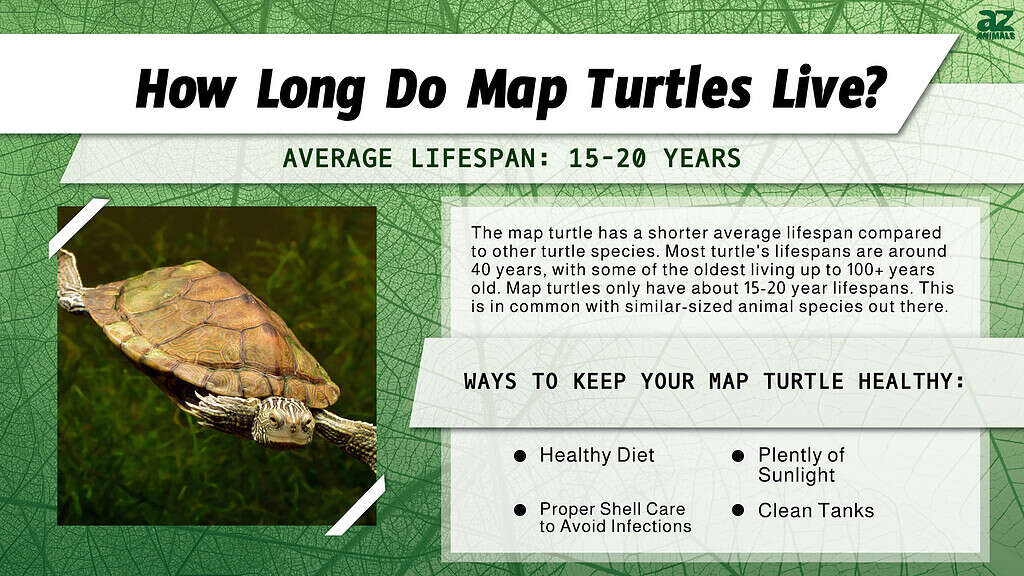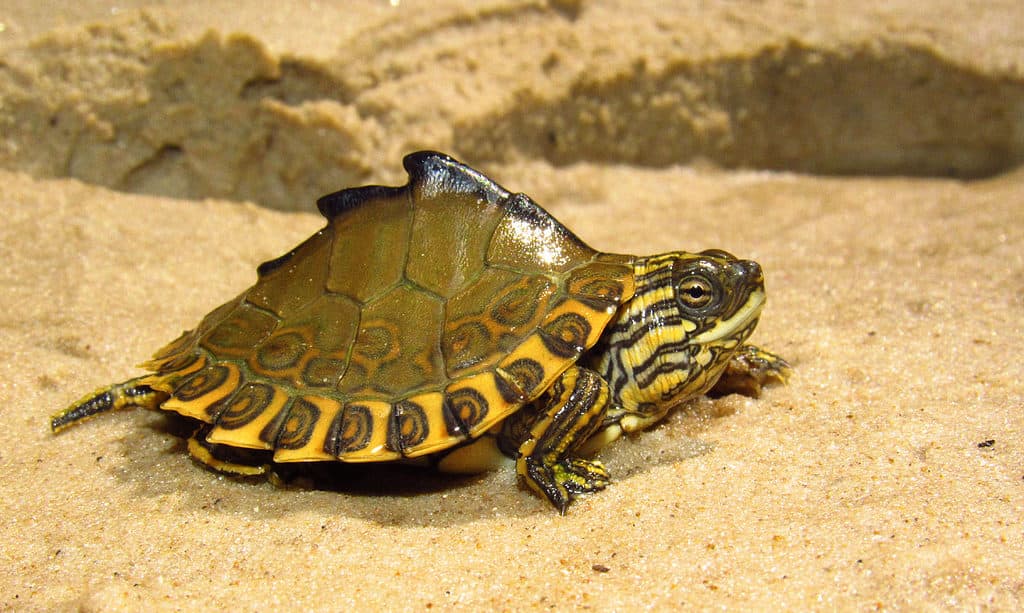Map turtles, known scientifically as Graptemys, are a genus of freshwater turtles. These turtle species can be found throughout most of North America, typically between the southern United States and northern Canada. One of the most common spots to find map turtles is in the Great Lakes of Michigan! Being freshwater turtles, the Great Lakes give plenty of habitat for the turtles to settle in!
Out of the 14 species of map turtles, 7 are listed as endangered, vulnerable, or near threatened by the International Union for Conservation of Nature. This makes the map turtle high on the watch list for preserving its genus. By learning more about the map turtle, you’ll get lots of amazing insight into this amazing genus of turtles and how important they are to the ecosystem!
Lifespan

Map turtles get their name from the design on their shells.
©RLS Photo/Shutterstock.com
The map turtle has a shorter average lifespan compared to other turtle genera and species. Most turtle’s lifespans are around 40 years, with some of the oldest living up to 100+ years old! The map turtle sadly only has about 15-20 year lifespan. This is in common with similar-sized animal species out there. Map turtles are on the smaller side for turtles, contributing to their shorter lifespan. A common trend in animal biology is that the smaller the cell, the quicker the animal will pass. This is because the smaller cells of animals are metabolically quicker burning compared to larger cells in other animals, thus making their lifespans smaller. The map turtle is sadly no exception to this.
One of the longest-living map turtles in captivity was 31 years old! The turtle was a Barbours map turtle, and was alive in human captivity for its life! The turtle lived in the National Zoo in Washington D.C. and brought many visitors joy and happiness! With proper care in captivity, the life span of different species of map turtles varies! The Pascagoula Map Turtle can live up to an estimated 50 years with proper care and treatment, growing alongside its owner throughout life. The Ringed and Ouachita Map Turtle can both live up to 30 years as well! The hard part about caring for animals that have long lifespans is that a lot of the time, the researchers wanting to learn more are not even alive at the time the animal is born!
On average, captive map turtles live longer compared to their wild counterparts. Different research shows that a captive turtle can live twice as long as a wild turtle. This is due to a multitude of reasons that impact the turtle’s health and well-being. For example, constant food access and a clean environment allow the turtle to maintain proper nutrients, health, and happiness. These factors lead to a long life and plenty of joy for all who visit the turtle.

Size
The size of map turtles depends greatly on their breed and sex. Map turtles are on the smaller size for most turtles. Just like humans, map turtles are sexually dimorphic, a term used to describe differences between male and female animals. Map turtles are almost opposite to humans in this sense as females are on average larger than male map turtles. A female map turtle can grow somewhere between 7-10.5 inches long and can weigh somewhere between 1.5-5.5 lbs. Male map turtles grow to be about 3.5-6.5 inches in length and can weigh somewhere between 5.3-14.1 oz. The difference in size is so great for weight that the unit of measurement has to be adjusted.
The Pascagoula Map Turtle is one of the larger map turtle species! This species will generally grow to around 11 inches for females, and 5 inches for males. This is in comparison to some of the smaller turtles such as the Texas Map Turtle whose female population tends to grow to around 5 inches, and males grow to 3 inches. The map turtle is a versatile genus of turtles, and learning to care for one is pretty straightforward! If you have an interest in taking care of one of these turtles, consider the size of the turtle as well! A smaller turtle will typically require less food and water, making it easier to manage over time!
How to Care For

The Pascagoula map turtle is considered the second-rarest Graptemys species.
©Gabbie Berry/Shutterstock.com
Map turtles are a highly sought-after pet turtle for their straightforward care and size. There are a few things that you need to take into account when considering taking care of a map turtle. Things like environment and enclosure, diet, health, and cleanliness are all important to the well-being of a turtle. Any shortcomings in these areas can cause a turtle to be unhappy and suffer a bit, so be careful with how you take care of them.
Enclosure
There are a few map turtle-specific requirements that ensure the health and happiness of a pet! The first is making sure the tank is the right size. Because of the physical environment that the map turtles know, a 20-gallon tank is perfect for the size of a map turtle! There also needs to be plenty of oxygen flow into the freshwater tank. Since map turtles are used to busybodies of water such as rivers and creeks, the oxygen flow allows for not only good health of the tank but also a simulation of the environment they are adapted to! Filters should also be in the tank and cleaned regularly to ensure the turtle is ingesting clean water. Overall, tank care of a map turtle is straightforward, and should not be too much of a hassle. By doing regular upkeep, a tank should last a while!
Proper decorations and sunbathing areas are also beneficial to turtles! If you have ever been near a lake and seen turtles resting on logs, this is also what tank turtles would like to do! Having places in your tank that are dry helps keep the map turtles happy and content! Decorations also help to separate and prevent any conflict in tanks with multiple turtles! If you do have multiple turtles, make sure there is enough room so that the larger turtles do not bully and harm the smaller ones.
Diet
Map turtle diets are straightforward as these turtles are omnivores that eat mostly plants. Turtle food can be bought, but leafy green plants like romaine and turnip greens are perfect for the turtle’s health. Younger map turtles tend to eat more greens compared to adults, so keep that in mind when caring for young ones! Adult map turtles tend to eat more shellfish such as snails and crayfish. They also consume insects such as crickets! The plants required to feed a map turtle you can buy at grocery stores, but other foods like crickets will need to be purchased at pet stores.
For younger map turtles, it is ideal to feed them every day to help with growing. Once they are adults, however, they only need to be fed every 2-3 days. Take into account however that every species and every individual map turtle is unique and may require different diets. Consider consulting a vet or other professionals about the best diet and plan for your map turtle!
Health
Caring for a map turtle is very straightforward. Beyond just a healthy diet, however, there needs to be good shell care as well! The shell of a map turtle can easily develop fungal infections as well as other infections. One of the best ways to prevent this is proper cleaning of the shell. One often-unconsidered thing is proper sunlight. Sunlight helps to prevent any fungal growth on the shell and provides vitamins to the turtle. Without sunlight, the turtle is at risk of developing other health issues.
Summary
In short, map turtles are a fun pet to keep! They are very straightforward and fun, and an interesting pet to keep! It’s not every day that you meet a turtle owner! Consider a map turtle as a pet in the future!
The photo featured at the top of this post is © Gabbie Berry/Shutterstock.com
Thank you for reading! Have some feedback for us? Contact the AZ Animals editorial team.







